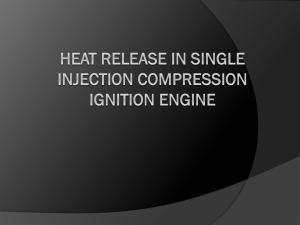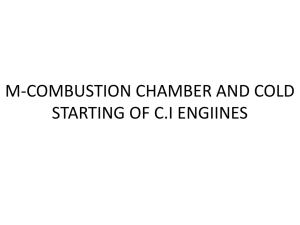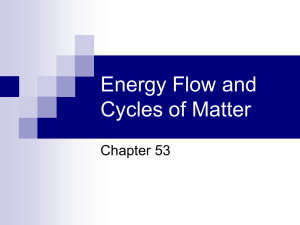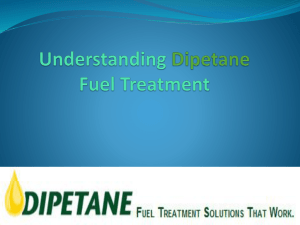Presentation_7a-_Combustion_2
advertisement
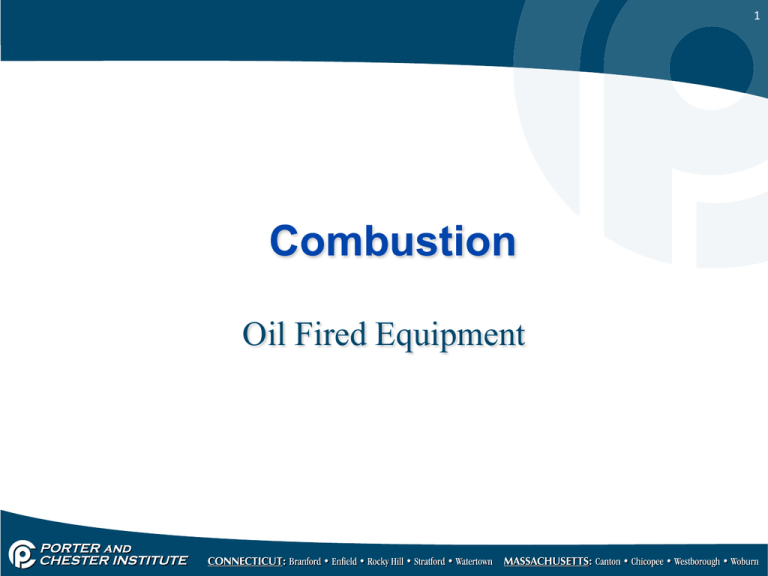
1 Combustion Oil Fired Equipment 2 OIL • Combustion of oil fired equipment has the same basics of gas. • Remember, Oil is a liquid and this must be converted to gas first. • Oil also does not flow freely, it must be piped. 3 Oil • Oil equipment uses an oil burner to pump the fuel from the tank. • The pump then pumps the fuel to the nozzle at a standard 100 psi. • The nozzle meters the fuel and sprays it into an air stream that is also caused by the burner. 4 Oil • This mixes the fuel and the air and the fuel is atomized, it is a fine mist as it comes out of the burner. • The atomized fuel is then ignited. The first source of ignition is the igniters. The continued heat for combustion comes from the fire itself. 5 Oil • The amount of time oil vapor has to combust, this is the amount of time it resides in the burning zone in front of the burner has been improved in recent years with Flame Retention burners. 6 Oil • Flame retention burners violently spin the air fuel mixture. This results in a better mixing and reduces the amount of excess air needed to ensure that each droplet of fuel is surrounded by oil. • Increasing the pump pressure from a standard of 100 psi to 140 psi also results in finer atomization of oil droplets 7 Oil • As the pump pressure is increased the nozzle size must be reduced to compensate for the higher pressures. • Every oil nozzle is sized based on 100 psi of oil pressure. • Example is a 1.50gph nozzle. This nozzle will provide 100 gallons per hour at 100 psi. 8 Oil • If the pump pressure on a 1.25 nozzle is increased to 140 psi the nozzle is now delivering 1.48 gph of oil. • To maintain the 1.25gph at the high pump pressure the nozzle size must be dropped to 1.05. • See chart on page 73 of manual. 9 Controlled Combustion • With oil you can control the: – Amount of Oil – The amount of air – The amount of draft 10 Oil • Oil contains 140,000 BTU of fuel. So burning 1 gallon of fuel in 1 hour produces 140,000 BTU/Hr. 11 Fuel Delivery • Check and make sure all fittings are tight. • Make sure vent and fill pipes are not clogged. • Mae sure all fittings are not leaking. Remember the pump is sucking oil from the tank, the leak may allow air in. 12 Fuel Delivery • On every furnace cleaning you must check the pump pressure. Verify it is at the manufactures recommended pressure and verify the correct nozzle size. • The name plate or data plate will give you this information. 13 Fuel Delivery • In oil - Never use compression fittings. Always use hard piped flare fittings. • As a part of oil burning we must verify and maintain draft over the fire. It is impossible to control the amount of air being delivered if the draft over the fire is not correct and stable. • The barometric damper (or draft control) is there for this purpose. 14 The combustion Process • As with Natural Gas, nitrogen is introduced into the combustion process. • For every percent increase of oxygen in the combustion process you have 3.76% more nitrogen and flue gas. • In most situations this results in Nitric Oxide (NO) or Nitrogen Dioxide (NO2) 15 The Combustion Process • Both NO and NO2 are toxic substances and controlled in many areas. 16 Oil Combustion • Burning: – 1 Pound Pure Oil • Requires – 14.36 pounds (188 Cubic Feet) of Air • Plus – 7.18 Pounds (94 Cubic Feet) of Excess Air 17 Oil Combustion • Results in: – 1.18 Pounds Water – 56.1% Nitrogen (11.02 Pounds) (150 ft3) • Plus – 10.2% Carbon Dioxide (3.16 Pounds/27.2ft3) • Plus – 33.8% Excess Air (7.18 Pounds or 94 ft3) 18 Oil Combustion • Some levels of excess air are needed to ensure complete combustion it will also reduce the safe efficient operation of the heating system. • This is why we do combustion and efficiency testing yearly. 19 Types of Efficiencies • Combustion Efficiency is a calculated measurement of how well the heating equipment is converting a set amount of fuel into useable heat. • Roughly looks at the known heat of oil, and the temperature and composition of the flue gas. • Compares this number with perfect combustion. 20 Efficiency Testing • 100% combustion efficiency is not possible due to the stack loss and boiler shell loss. • There are efficiencies from 0% to 95% available. • Remember that in fuels with a large Hydrogen to Carbon ratio more excess air must be provided. Oil has more Carbon. 21 Efficiency Testing • When fuel is burning those fuels with the lowest amount of Carbon produce the lowest amount of Carbon Dioxide. In most cases this would be Natural Gas. 22 NOx • The primary nitrogen pollutants produced by combustion are nitric oxide and nitrogen oxide. • Increasing evidence exists that nitric oxide has a direct negative effect on the respitory system. • Also NOx reacts with moisture in the air and forms acid rain and ozone. 23 NOx • Instruments that measure NO usually read them in PPM. • NO readings must also be adjusted for excess air. 24 Oxides of Nitrogen • NO is formed in one of three ways: – Thermal NO - produced when nitrogen and oxygen combustion air supply combine at high temperatures. This is normally produced during the combustion of gases and fuel oils. – Fuel NO is produced when nitrogen in the fuel combines with the excess oxygen in the combustion air and is only a problem with fuel oils containing fuel bound nitrogen. 25 Oxides of Nitrogen – Prompt NO is formed during the early, low temperature states of combustion and is insignificant. 26 Control of NO • There are several ways NO can be controlled. – Reducing the amount of O2 that is available to bind with nitrogen during combustion. This means properly tuning the burner or furnace. – Burning low nitrogen fuel oils - bio-fuels. 27 Control of NO – Injecting water or steam into the flame to reduce the flame temperature thus lowering overall NO production as much as 80% for gas. (Note: This lowers boiler efficiency as much as 10% depending on the amount of steam or water injected.) – Recirculating flue gas back into the combustion process as combustion air. This effectively “re-burns” the fuel. 28 Control of NO • All control of NO must be done per local, state and federal code. • Also refer to equipment manufacturers specifications prior to making any changes.

